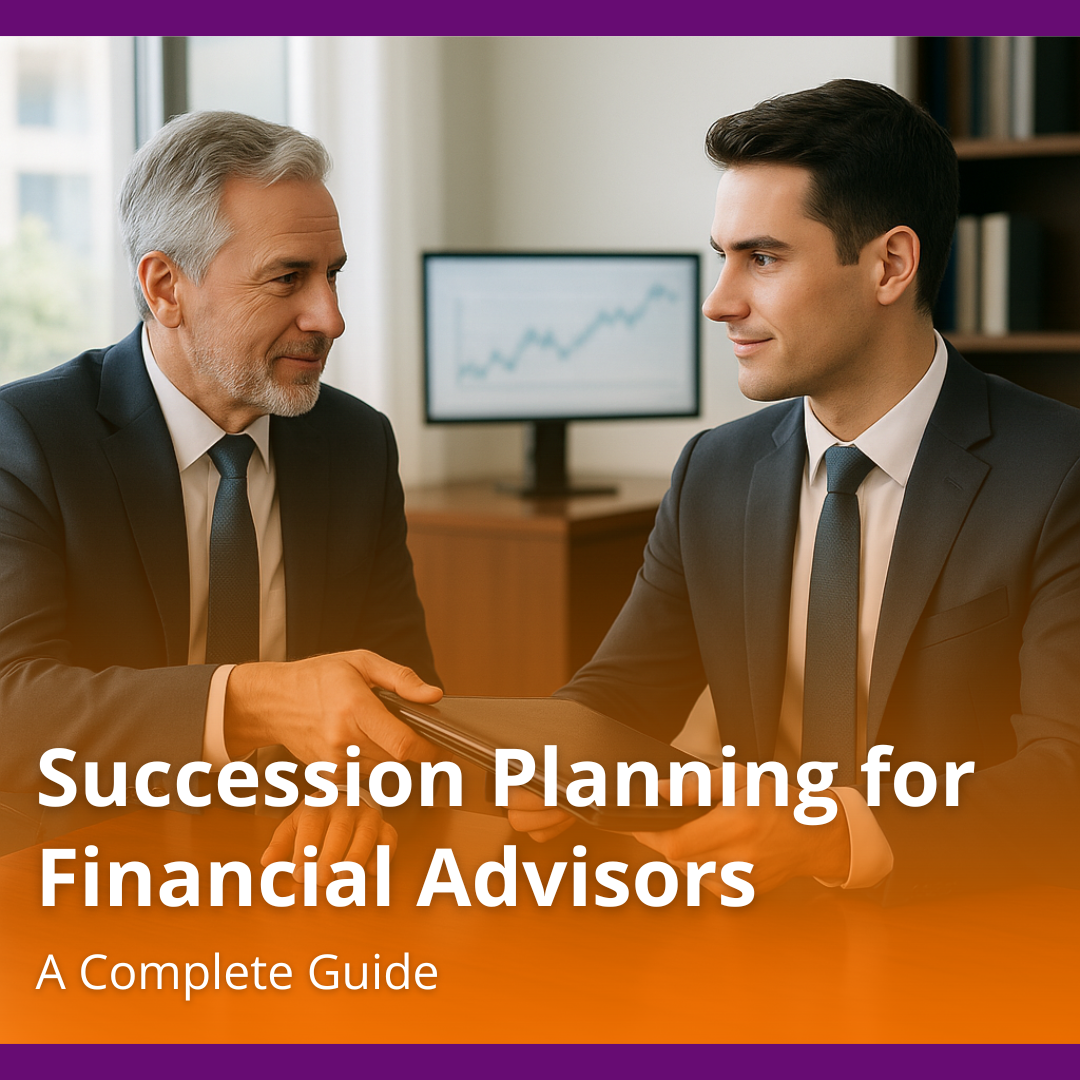Thinking of Selling Your Business? Document Your Operations First
Running a business means knowing every moving part. But to a buyer, that knowledge means nothing if it isn’t documented. And that’s a...
Comprehensive, data-driven valuations and comparative equity analyses to accurately price your practice, establish market benchmarks, and support informed decision-making.
Comprehensive M&A guidance encompassing deal structuring, negotiation strategies, market listings, and transaction closings.
Comprehensive systems, targeted coaching, and in-depth assessments designed to optimize operational efficiency and enhance advisory team effectiveness.
Strengthen continuity through the implementation of formal continuity agreements, the establishment of legal entities, execution of enforceable legal contracts, and securing appropriate capital resources.
7 min read
 Anthony Whitbeck, CFP®, CLU®
August 8, 2025
Anthony Whitbeck, CFP®, CLU®
August 8, 2025

Succession planning is no longer optional. It is a business imperative. As of mid-2025, 94% of firm owners nearing retirement lack a fully documented succession plan, according to a report from AdvisorHub. That gap creates significant risk not only for firm valuation, but for client continuity and staff retention.
If you're preparing the next generation to take over your advisory business, ask yourself: Are they truly ready to lead? Do your clients trust them? Have you built a plan that preserves your legacy and your firm's long-term value?
The sooner you address these questions, the stronger your transition will be, and the more confident everyone will be in the future of your business.
Advisors help clients plan for the future. Yet many postpone planning their own exit. The importance of succession planning is clear: without a defined strategy, the advisory business you’ve built is exposed to client loss, valuation decline, and operational risk. A well-structured succession plan ensures business continuity, protects your team, and preserves long-term client relationships.
Clients want to know their advisor won’t leave them in limbo. A successful succession plan introduces a successor early, giving clients time to build trust and adjust. Done right, it maintains consistency in financial planning and strengthens retention through the transition. Without clear communication, client trust erodes—and so does retention.
Without a documented plan, your firm’s market value can drop sharply. Buyers are wary of disorganized transitions, and successors may not be willing, or able, to step in without clear roles and timelines. A formal financial advisor succession plan increases buyer confidence, supports fair business valuation, and ensures the business continues in line with your vision.
Regulators expect firms to protect clients during ownership changes. FINRA and the SEC urge firms to create formal continuity and transition planning processes. For practices managing large assets under management, lacking a plan can raise red flags and compliance issues. Documented succession supports stability, client protection, and long-term viability.
Even the most experienced financial professionals struggle to move from intention to execution. The succession planning process is complex, and for many advisors looking to retire, the path forward is unclear. Here are five challenges that often delay or derail the creation of a clear succession plan.
For many business owners, their firm represents more than revenue—it’s their identity. This emotional attachment often delays planning. But the longer you wait, the fewer choices you’ll have. Advisors who start early can take control of the succession process and build a solid succession strategy that supports both their retirement plan and the future of the business.
Not every new advisor is ready to take over the business. Choosing a successor means evaluating leadership skills, cultural fit, and the ability to maintain client relationships. Whether you're pursuing internal succession or considering another advisor, grooming takes time. A succession plan in place helps define expectations and gives you room to correct course before handing over control.
Setting the price for the business is never simple. Many advisors say they struggle with business valuation, deal terms, and payout structures. Earn-outs, seller financing, and equity swaps all play a role in succession planning. Without professional guidance, it's easy to undervalue the firm—or scare off a strong buyer. Clear terms and defined roles and responsibilities ensure a smooth transition for both parties.
A successful transition must account for more than just revenue. Advisors must prepare their employees and clients, meet regulatory expectations, and preserve firm culture. A strong succession plan helps maintain trust and minimize disruption throughout the business transition. Compliance concerns can derail deals late in the process, so it’s critical to map out everything from client consent to licensing logistics in advance.
Succession planning isn’t something you handle six months before retirement. The average age of financial advisors continues to rise, and yet many wait far too long to create a succession plan. Advisors who want to retire on their terms must create a plan that aligns with their financial goals, firm values, and exit timeline. It’s never too early to start thinking about how to protect your book of business, team, and clients.
Advisors must choose how to transfer ownership and leadership through internal grooming, an external sale, or a hybrid of both. The decision shapes the future of your business, affects client retention, and determines long-term market value.
Grooming a successor from within offers the strongest continuity. The new advisor already understands your advisory business, firm culture, and clients. This path supports a smoother business transition and often leads to higher client and staff retention due to familiar systems and trusted relationships.
However, it requires time, mentorship, and a formal plan. Advisors must communicate the succession plan early and clearly to avoid confusion and build trust throughout the process.
If no internal candidate exists, or if maximizing valuation is the priority, selling to a large registered investment advisor or aggregator may be the answer. These firms offer capital, back-office support, and infrastructure. But cultural misalignment can risk client relationships.
External buyers can bring capital and scale, but advisors must do their homework. The right partner should understand your firm's values and commit to client continuity. For a deeper look at how to prepare your firm for sale, read our guide. You may also find value in our guide on selling a financial advisory practice, which explores how to position your firm for a successful sale.
Some advisors pursue both paths: selling a minority stake while mentoring an internal leader. This hybrid gives you financial flexibility, preserves financial advisory culture, and provides a phased exit. It’s a smart option for those who plan to retire gradually but still want to guide the firm and support clients during the succession process.
| Strategy | Best For | Key Advantages | Trade-Offs |
|---|---|---|---|
| Internal | Advisors grooming a successor | Client continuity, cultural fit | Long lead time, the successor must be ready |
| External | Advisors maximizing valuation or with no internal option | Capital, infrastructure, fast exit | Higher client attrition risk, cultural mismatch |
| Hybrid | Advisors wanting flexibility and phased exit | Retain control, ease financing | Complex in structure, it requires balance |
Succession planning takes time, and for most financial advisors, the hardest part is knowing where to start. The goal is to ensure continuity, protect market value, and prepare your advisory business for long-term success. Advisors who follow a structured process are far more likely to achieve a successful succession.
Here are six essential steps to build a successful succession plan that protects your firm, clients, and legacy.
Start by identifying your ideal exit window. Do you want to plan to retire in three years or reduce day-to-day involvement over a decade? Consider your financial security, lifestyle, and vision for the business you’ve built. These decisions affect everything, from deal structure to client transition pacing.
A clear exit timeline also helps set expectations for business operations, especially if you plan to lead the firm in a limited role post-transition.
Advisors need time to develop leadership. Start by evaluating team members for their ability to manage client relationships, adapt to change, and align with your firm's values. For many firms, the best path forward is grooming a successor from within. But only if that person is prepared to take on full ownership.
This step plays a crucial role in long-term continuity and should begin at least five years before your exit.
A financial advisor succession plan is only effective if it includes a clear roadmap for transferring both leadership and trust. Create a phased plan with defined roles and responsibilities, client handoff stages, and internal communication protocols.
Financial advisors need to communicate the succession plan early and often, especially to clients, staff, and partners. Successful transitions are built on transparency and confidence.
Work with legal and tax professionals to create binding documents: buy-sell agreements, equity transfer terms, and contingency protocols. These components protect all parties and ensure a smooth business transition.
Address business valuation early and revisit it regularly. Without a clear sense of value, successors can’t finance the deal, and business owners’ expectations may go unmet.
Need help navigating valuation and legal terms? Advisor Legacy's Practice Sales for Sellers offers step-by-step guidance tailored to financial advisors.
The succession plan should support your broader estate plan and personal wealth management strategy. Coordinating with your financial planner ensures the transition meets retirement, tax, and inheritance goals.
Succession planning gives you the chance to integrate exit timing with your long-term financial goals, providing clarity for both your family and firm.
Successor readiness, market dynamics, and firm priorities all shift over time. Revisit your plan annually, adjust timelines, and run 'what-if' scenarios to ensure it stays relevant.
Financial advisors say that reviewing their plan annually increases the likelihood of a successful transition and ensures the strategy remains aligned with both personal and business realities.
A financial advisor succession plan is only as strong as the person stepping in. Grooming a successor requires preparation, trust, and shared ownership. Here are five essential strategies to ensure your advisor practice remains strong throughout the transition.
1. Start Grooming Early
Successor development takes time. Advisors should begin the process five to seven years before their planned exit. This allows time to coach, evaluate, and build a plan that aligns with your long-term goals and investment objectives.
2. Document Everything
Institutional knowledge must be preserved. Use CRM systems to capture workflows, client data, and service standards. Well-documented operations support continuity and protect the market value of your advisory business.
3. Build Client Confidence Gradually
Clients need to experience the new advisor in action. Schedule joint meetings, delegate lead roles, and introduce them as a future leader. A strong transition depends on how clearly and consistently you communicate the succession plan to clients.
4. Align Incentives Through Equity
Offer meaningful ownership opportunities. Staged buy-ins, equity grants, or profit-sharing help retain top talent and create a shared vision. These models work well in financial advisory firms preparing to hand off to the next generation.
5. Coach Beyond the Numbers
Successors need more than technical skill. Focus on leadership development, relationship management, and communication. These are the traits that allow them to guide the firm, retain clients, and deliver a truly successful succession.
Ignoring legal and financial structuring can derail even the most thoughtful succession planning for financial advisors. Advisors must address documentation, valuation, and compliance not only to protect market value but to ensure a smooth business transition and regulatory alignment.
RIAs are expected to develop written business continuity and succession plans, including policies for client communication, IT resilience, and transition procedures, which are in line with the SEC’s proposed Rule 206(4)-4 and NASAA’s model rules (US Securities and Exchange Commission)
Firm value drives exit strategy. Common valuation methods include revenue or EBITDA multiples adjusted for retention rates, client demographics, and firm growth. Engaging third-party valuation specialists is standard practice in the financial services industry, especially when financing or ownership transfer is involved.
Curious how valuation strategies align with external succession planning? Our post on selling a financial advisory practice dives deeper into methods for maximizing firm value, attracting qualified buyers, and structuring deals that preserve your legacy.
The buy-sell agreement is the legal backbone of a financial advisor succession plan. It outlines who can buy, how much, under what terms, and when. Advisors should include clauses for death, disability, retirement, and forced exits. For Registered Investment Advisors (RIAs), such agreements help fulfill continuity obligations under SEC Rule 206(4)-7, which requires written policies to address business continuity and succession scenarios.
Poor tax structuring can erode firm value and cash flow. Advisors should consider installment sales, capital gains optimization, and insurance-funded buyouts as tools for reducing tax exposure. Coordinating with tax and legal experts ensures alignment with state and federal laws, while also avoiding surprises that can destabilize a transition.
A structured succession plan does more than protect your business. It positions your firm for long-term stability, growth, and leadership continuity. Advisors who start early gain more control, more leverage, and greater peace of mind throughout the business transition.
Succession planning also strengthens relationships with clients, staff, and successors. It signals leadership, intention, and long-term commitment to the advisory business you’ve worked hard to build.
Contact Advisor Legacy today to build your personalized succession plan.
Anthony "Tony" Whitbeck, CFP®, CLU®, is CEO and Owner of Advisor Legacy. He began his career as a financial advisor in 1989 and later shifted to coaching, where he’s guided more than two hundred advisory practices through growth, valuation, and succession. Tony leads Advisor Legacy’s certified third-party valuation engagements and coordinates lending and legal partners to streamline transactions. His articles focus on building transferable enterprise value, mapping internal vs. external exits, and avoiding common succession pitfalls. Drawing on decades of in-the-trenches experience, Tony provides practical, compliance-friendly guidance advisors can use right away.
Receive timely articles, tip sheets, events, and more right in your inbox.

Running a business means knowing every moving part. But to a buyer, that knowledge means nothing if it isn’t documented. And that’s a...

Growing by acquisition is one of the fastest ways to scale — but it’s also one of the easiest ways to stumble. Behind every successful deal is a...

The M&A landscape in financial services isn’t slowing down. It’s evolving. Fast. As of mid-2025, deal values in the sector have surged by...